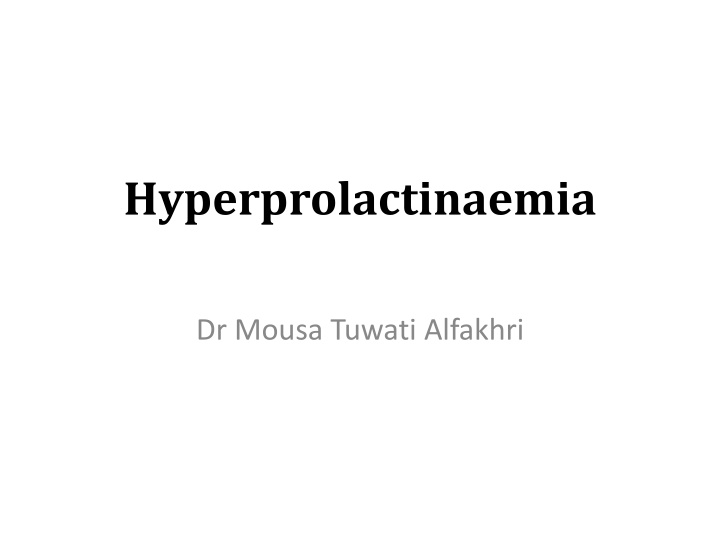
Hyperprolactinaemia
Learn about hyperprolactinaemia, a condition characterized by high levels of prolactin hormone, its causes including physiological and pathological factors, clinical features like galactorrhoea and subfertility, and how it is diagnosed through investigations such as measuring serum prolactin levels and ruling out primary hypothyroidism. Images provided for better understanding.
Uploaded on | 0 Views
Download Presentation

Please find below an Image/Link to download the presentation.
The content on the website is provided AS IS for your information and personal use only. It may not be sold, licensed, or shared on other websites without obtaining consent from the author. If you encounter any issues during the download, it is possible that the publisher has removed the file from their server.
You are allowed to download the files provided on this website for personal or commercial use, subject to the condition that they are used lawfully. All files are the property of their respective owners.
The content on the website is provided AS IS for your information and personal use only. It may not be sold, licensed, or shared on other websites without obtaining consent from the author.
E N D
Presentation Transcript
Hyperprolactinaemia Dr Mousa Tuwati Alfakhri
Prolactin Prolactin is large peptide secreted in pituitary. It is under tonic dopamine inhibition TRH stimulates prolactin secretion it stimulates milk secretion ( not breast tissue development) also inhibits gonadal activity.
Causes of hyperprolactinaemia Physiological Stress (e.g. post-seizure) Pregnancy Lactation Nipple stimulation Sleep Coitus Exercise Drug-induced Antipsychotics (phenothiazinesand butyrophenones) Antidepressants Antiemetics (e.g.metoclopramide, domperidone) Oral contraceptive pill Pathological Disconnection hyperprolactinaemia (e.g.non-functioning pituitary macroadenoma) Prolactinoma ,usually microadenoma Primary hypothyroidism Polycystic ovarian syndrome Renal failure
Clinical features Galactorrhoea Oligomenorrhoea or amenorrhoea Decreased libido in both sexes Decreased potency in men Subfertility Mild gynaecomastia is often seen in men due to associated hypogonadism rather than direct effect of prolactin headaches and visual field defects if there is pituitary tumour (more common in men).
Investigations Hyperprolactinaemia should be confirmed by repeat measurement. upper limit of normal for many assays of serum prolactin is approximately (24 ng/mL). Pregnancy should first be excluded before further investigations are performed .
In non-pregnant and non-lactating patients, prolactin concentrations of (24 47 ng/mL) are likely to be induced by stress or drugs. Levels between 47 236 ng/mL are likely to be due to either drugs,a microprolactinoma or disconnection hyperprolactinaemia. Levels above 236 ng/mLare highly suggestive of macroprolactinoma.
T4 and TSH should be measured to exclude primary hypothyroidism causing TRH-induced prolactin excess. Unless prolactin falls after withdrawal of relevant drug therapy, a serum prolactin consistently above the referencerange is an indication for MRI or CT scan of the hypothalamus and pituitary.
Prolactinoma It is prolactin secreting pituitary adenoma ,most common hormone-secreting pituitar adenoma Most prolactinomas in pre-menopausal women are microadenomas (< 1cm)because symptoms of prolactin excessusually result in early presentation. In prolactinomas there is relationship between prolactin concentration and tumour size: the higher the level, the bigger the tumour. Some macroprolactinomas can elevate prolactin concentrations above 4700 ng/mL.
Management Medical (Bromocriptine, Cabergoline) Dopamine agonist drugs are first-line therapy for the majority of patients They usually reduce serum prolactin concentrations and cause significant tumour shrinkage after several months of therapy
Bromocriptine 2.5 15 mg/day ,2 3 times daily Short half-life; useful in treating infertility Proven long-term efficacy Ergotamine-like side-effects (nausea, headache, postural hypotension, constipation) Frequent dosing so poor adherence Rare reports of fibrotic reactions in various tissues
Cabergoline 250 1000 g/week,2 doses/week Long-acting, so missed doses less important Reported to have fewer ergotamine-like side-effects Limited data on safety in pregnancy Associated with cardiac valvular fibrosis
Surgery and radiotherapy Second line treatment Surgical decompression when macroprolactinoma has failed to shrink sufficiently with dopamine agonist therapy Surgery may also be performed in patients who are intolerant of dopamine agonists. Microadenomas -trans-sphenoidal surgery with cure rate of about 80%, recurrence is possible; cure rate in macroadenomas is substantially lower. External irradiation some macroadenomas to prevent regrowth if dopamine agonists are stopped.
